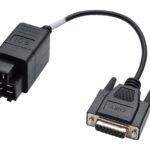Connecting your Bluetooth OBD2 scanner to your smartphone or tablet is the first crucial step to unlocking your car’s diagnostic data. This process often requires a PIN code to establish a secure Bluetooth connection. This guide will walk you through the straightforward steps to pair your Bluetooth OBD scanner, focusing on finding and using the correct PIN.
Step #1: Initiate Bluetooth Pairing on Your Device
If this is your first time connecting your OBD2 adapter to your phone or tablet, you’ll need to pair the devices via Bluetooth. If you’ve already completed this step, you can skip to Step #2.
To begin, ensure your OBDII ELM327 Bluetooth adapter is correctly plugged into your vehicle’s OBDII port. This port is typically located under the dashboard on the driver’s side. Once plugged in, turn your car’s ignition to the “ON” position (or start the engine). This powers up the adapter. If your adapter has a power button, make sure it is switched on.
Now, on your Android device, navigate to the Bluetooth settings menu. This is usually found within your device’s main “Settings” app, under “Connections” or a similar category. Turn Bluetooth on and allow your device to scan for nearby Bluetooth devices.
After a few moments, your OBD2 adapter should appear in the list of available devices. It commonly appears as “OBDII”, “obd2”, or a similar generic name. If you have a branded adapter, it might display its brand name such as “Viecar” or “VLink”. Importantly, it will not be named after your car brand or something like “MY CAR”.
Tap on your OBD2 adapter’s name to initiate the pairing process. Your device will then prompt you to enter a PIN code to complete the Bluetooth pairing. This is where the “Bluetooth Obd Scanner Pin” becomes essential.
If you are unsure of the PIN code for your Bluetooth OBD scanner, the first place to check is the documentation that came with your adapter. Manufacturers usually include the PIN in the user manual or on a small card in the packaging.
However, if you cannot locate the documentation, don’t worry. Many Bluetooth OBD2 adapters utilize common default PIN codes. Try these frequently used PINs:
- 1234
- 0000
- 7890
- 1111
One of these PIN codes will likely be the correct one for your adapter. Enter the PIN and tap “Pair” or “OK” to finalize the Bluetooth pairing process. Once successfully paired, your OBD2 adapter will be saved in your device’s list of paired Bluetooth devices.
Step #2: Select Your Adapter in Your Car Scanner App
With your Bluetooth OBD2 adapter successfully paired to your device, the next step is to select it within your car scanner application. For this example, we’ll use the “Car Scanner” app, but the process is similar for other OBD2 apps.
Open the Car Scanner app on your Android device. Locate and tap the “Settings” icon, usually represented by a gear symbol, in the top-right corner of the app’s main screen.
Within the Settings menu, find and select the “Adapter” option. In older versions of the Car Scanner app, this might be labeled as “Connection”.
Next, choose “Bluetooth” as the connection type. This tells the app to look for and connect via Bluetooth.
After selecting Bluetooth, tap on the “Select device” option. This will display a list of paired Bluetooth devices that your device has already recognized.
From the list, locate and tap on the name of your OBD2 adapter. This selects your adapter within the Car Scanner app.
That’s it! You have now successfully selected your Bluetooth OBD scanner in the Car Scanner app. To finalize the connection and start using your scanner, navigate back to the app’s main screen and tap the large, usually green, “Connect” button.
For subsequent uses, after you have initially paired and selected your adapter, all you will need to do is ensure your adapter is powered on (plugged into your car and ignition ON, or power button pressed) and then simply tap the “Connect” button within the Car Scanner app.
By following these steps, you can easily pair your Bluetooth OBD scanner using the correct PIN and connect it to your car scanner app, enabling you to access valuable diagnostic information about your vehicle.

